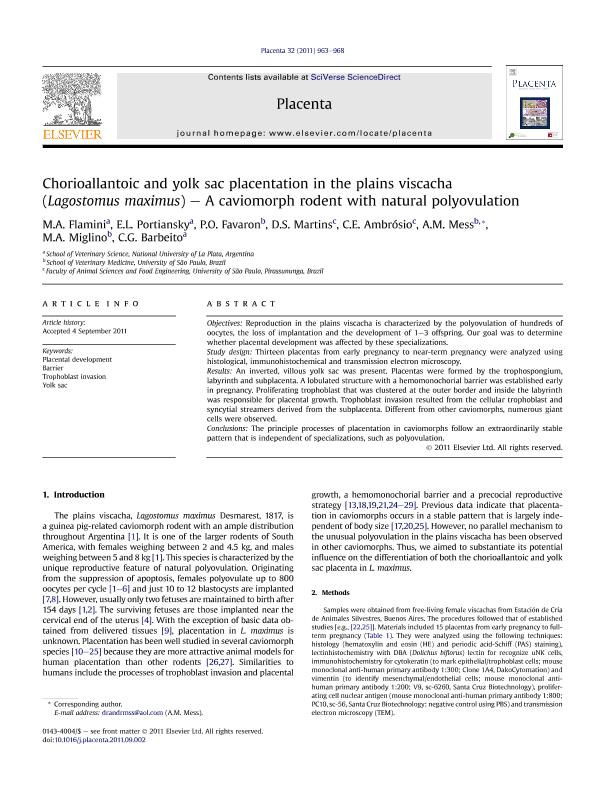Artículo
Chorioallantoic and yolk sac placentation in the plains viscacha (Lagostomus maximus) - A caviomorph rodent with natural polyovulation
Flamini, Mirta Alicia; Portiansky, Enrique Leo ; Favaron, P. O.; Martins, D. S.; Ambrósio, C. E.; Mess, A. M.; Miglino, Monica Andrea; Barbeito, Claudio Gustavo
; Favaron, P. O.; Martins, D. S.; Ambrósio, C. E.; Mess, A. M.; Miglino, Monica Andrea; Barbeito, Claudio Gustavo
 ; Favaron, P. O.; Martins, D. S.; Ambrósio, C. E.; Mess, A. M.; Miglino, Monica Andrea; Barbeito, Claudio Gustavo
; Favaron, P. O.; Martins, D. S.; Ambrósio, C. E.; Mess, A. M.; Miglino, Monica Andrea; Barbeito, Claudio Gustavo
Fecha de publicación:
08/2011
Editorial:
Elsevier
Revista:
Placenta
ISSN:
0143-4004
Idioma:
Inglés
Tipo de recurso:
Artículo publicado
Clasificación temática:
Resumen
Objectives: Reproduction in the plains viscacha is characterized by the polyovulation of hundreds of oocytes, the loss of implantation and the development of 1-3 offspring. Our goal was to determine whether placental development was affected by these specializations. Study design: Thirteen placentas from early pregnancy to near-term pregnancy were analyzed using histological, immunohistochemical and transmission electron microscopy. Results: An inverted, villous yolk sac was present. Placentas were formed by the trophospongium, labyrinth and subplacenta. A lobulated structure with a hemomonochorial barrier was established early in pregnancy. Proliferating trophoblast that was clustered at the outer border and inside the labyrinth was responsible for placental growth. Trophoblast invasion resulted from the cellular trophoblast and syncytial streamers derived from the subplacenta. Different from other caviomorphs, numerous giant cells were observed. Conclusions: The principle processes of placentation in caviomorphs follow an extraordinarily stable pattern that is independent of specializations, such as polyovulation.
Palabras clave:
BARRIER
,
PLACENTAL DEVELOPMENT
,
TROPHOBLAST INVASION
,
YOLK SAC
Archivos asociados
Licencia
Identificadores
Colecciones
Articulos(CCT - LA PLATA)
Articulos de CTRO.CIENTIFICO TECNOL.CONICET - LA PLATA
Articulos de CTRO.CIENTIFICO TECNOL.CONICET - LA PLATA
Citación
Flamini, Mirta Alicia; Portiansky, Enrique Leo; Favaron, P. O.; Martins, D. S.; Ambrósio, C. E.; et al.; Chorioallantoic and yolk sac placentation in the plains viscacha (Lagostomus maximus) - A caviomorph rodent with natural polyovulation; Elsevier; Placenta; 32; 12; 8-2011; 963-968
Compartir
Altmétricas



